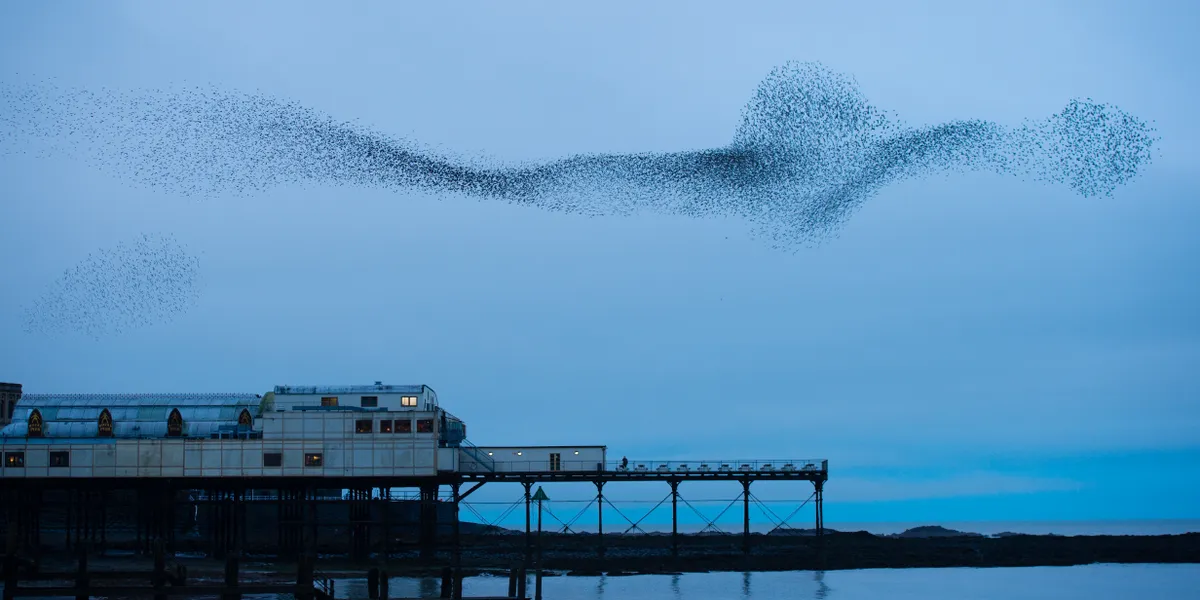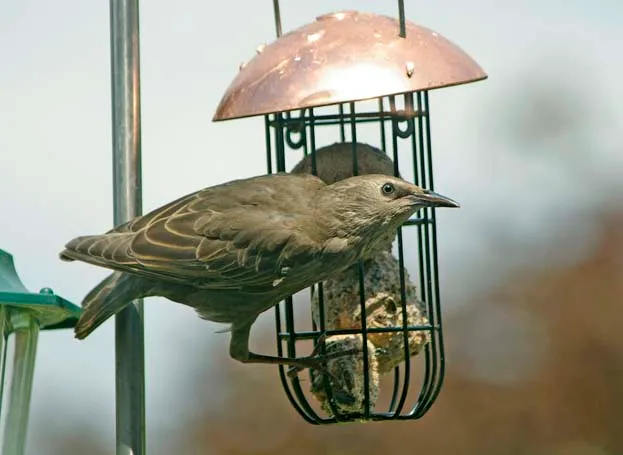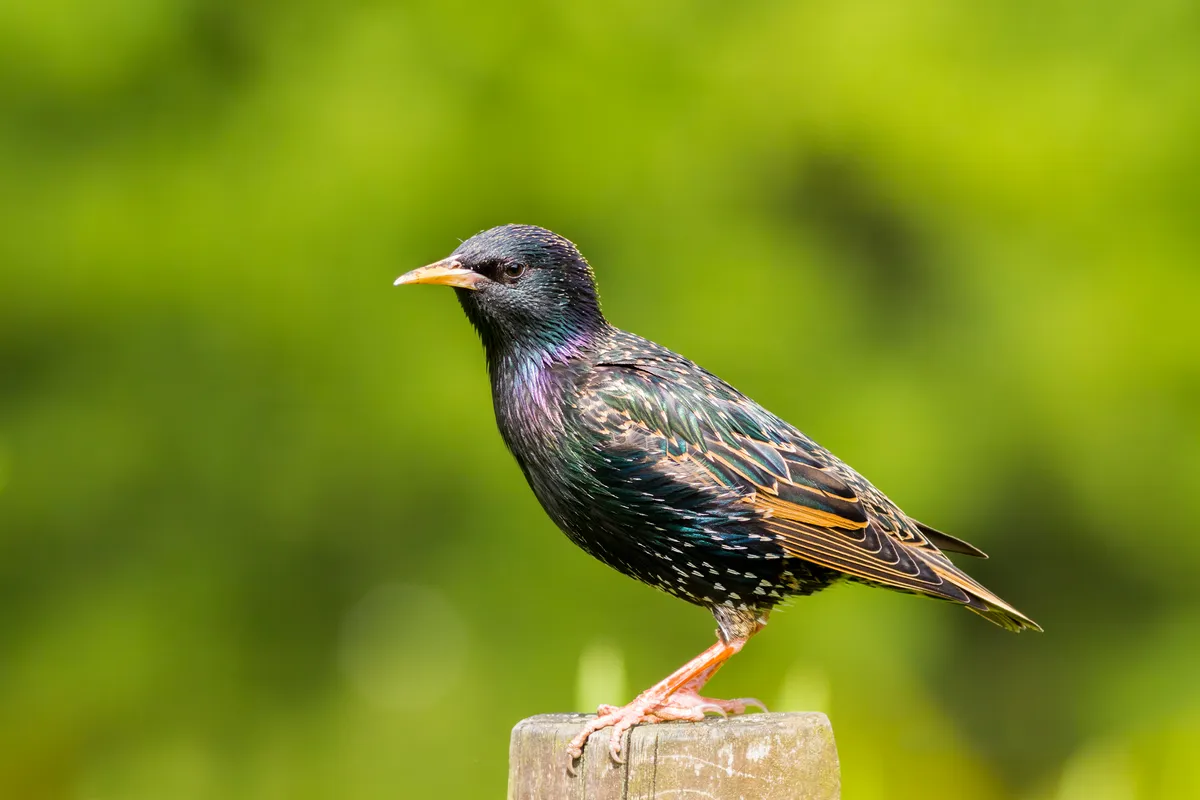Do starlings migrate?
Starlings use gardens all year round but in the winter our resident population is boosted by migrant birds from mainland Europe. Garden BirdWatch data reflects this with the number of gardens reporting starlings rapidly increasing from October onwards.
Starling murmurations
During the winter you may be lucky enough to see a starling murmuration. These flocks gather in the evening and perform amazing aerobatic displays before dropping into their favoured roost sites.
Flocks provide safety in numbers for birds returning to roost as predators find it hard to target individual birds. In addition, they benefit from the warmth of other birds and the opportunity to exchange information.

Starling murmurations are one of the most beautiful and enchanting natural sights in the UK. If you want to see one for yourself, check out this guide we wrote just for you!
Are starlings getting rarer?
The starling population has undergone a long-term population decline throughout Europe. In the UK this resulted in almost an 80 per cent population decrease between 1987 and 2012. The decline is thought to be linked to reduced feeding opportunities due to changing land use practices. It’s not all bad news however, as both recent Garden BirdWatch and the Breeding Bird Survey results show a slight upturn in numbers.
What do starlings eat?
During the breeding season, starlings rely on invertebrates, especially leatherjackets (the larvae of crane flies) taken from short grassland, including lawns. In the summer and autumn, they take more seeds and berries and this seasonal shift is matched by a lengthening of their intestine to cope with the increased plant material, which is harder to digest. They will readily use bird feeders throughout the year.
Smallest starling chicks put more effort into finding food
A difficult start in life is not necessarily a disadvantage.
Biologists have found that the smallest starling chicks learn behavioural strategies that produce fatter adults.
Starlings that struggle to compete for food in the nest grow up to forage more quickly and to put more effort into finding food – to the extent that they prefer to rummage through sand for hidden morsels rather than plumping for freely available food nearby.
A cost of the extra weight, though, is that the birds don’t fly as well as their advantaged peers, which may make them more vulnerable to predators.

Why do starlings’ beaks change colour?
A crucial part of avian anatomy, birds’ beaks are used as tools, weapons and much more – including communication. Beaks are formed from the jaw bones, covered with a skin-like layer toughened with keratin, and it is this layer that stores the pigments that provide colour to the beak.
Melanin gives starlings their dark winter beaks, but from November (later in migrant starlings) these start transitioning to yellow, ready for males to establish their breeding territories. This yellow coloration comes from carotenoid pigments, which the starlings cannot produce themselves but instead gain through their diet.
Since carotenoids also play an important role in avian immune systems, the intensity of yellow can be used by starlings as an insight into each other’s condition and potential parenting skills. A nice bright beak suggests a healthy bird. This is known as an honest signal, as the starlings are unable to manipulate its message – they’re forced to show their true colours.
Starling plumage
While starlings appear black at a distance, close up they have glossy green and purple iridescent plumage. In the breeding season, adults have yellow bills with different colour bases depending on their sex; in males this is blue and in females pink. Their winter plumage is duller with white spots and the bill is dark. Juveniles are dull brown in colour, often with a pale throat.

Why don't some people like starlings?
Quite a few garden birdwatchers complain about starlings because they seem to clean out a feeding station in minutes. Starlings do this as they evolved to feed quickly in flocks, rather than because they are greedy. It’s not their fault but it can get expensive so if this is a problem, try providing food, especially fat products, in feeders that exclude larger birds.
More guides to common British birds
- British garden birds guide: how to identify different species and attract them to your garden
- House sparrow guide: species facts, how to identify, and how to put up a nestbox for them
- Great tit guide: how to identify by sight and call, and what they feed on
- European robin guide: diet, habitat and species facts
- Common blackbird guide: species facts, how to identify males, females and juveniles
For more information about Garden BirdWatch or to speak to the Garden Ecology Team please email gbw@bto.org
The British Trust of Ornithology (BTO) works in partnership with over 40,000 volunteer birdwatchers to chart the fortunes of UK birds.
Main image © John Harding/BTO
